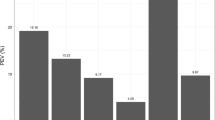Abstract
Scientific articles may be represented as points in a space whose spatial pattern reflects some of the substantive and social structures of science. The proximity of articles and the documents they reference leads to a centroid scalling method proposed in this paper. This method scales citing articles as close as possible to the articles they reference. The simultaneous scaling of citing and cited articles in a common space aids in the interpretation of the resultant configuration.
Similar content being viewed by others
Explore related subjects
Discover the latest articles and news from researchers in related subjects, suggested using machine learning.References
R. N. SHEPARD, Analysis of proximities: Multidimensional scaling with an unknown distance function. IPsychometrika, 27 (1962) 125–140.
R. N. SHEPARD, Analysis of proximities: Multidimensional scaling with an unknown distance function. II.Psychometrika, 27 (1962) 219–246.
J. B. KRUSKAL, Multidimensional scaling by optimizing goodness to fit to a nonmetric hypothesis,Psychometrika, 29 (1964) 1–27.
J. B. KRUSKAL, Nonmetric multidimensional scaling: A numerical method.Psychometrika, 29 (1964) 115–129.
R. L. BREIGER, S. A. BOORMAN, P. ARABIE, An algorithm for clustering relational data, with applications to social network analysis and comparison with multidimensional scaling,Journal of Mathematical Psychology, 12 (1975) 328–383.
H. H. HARMON,Modern Factor Analysis. The University of Chicago, Press, Chicago, 1967.
H. SMALL, E. GREENLEE, Citation context analysis of a co-citation cluster: recombinant-DNA,Scientometrics, 2 (1980) 277–301.
M. J. MORAVCSIK, P. MURUGESAN, Some results on the function and quality of citations,Social Studies of Science, 5 (1975) 86–92.
D. E. CHUBIN, S. D. MOITRA, Content analysis of references: an adjunct or alternative to citation counting?Social Studies of Sciences, 5 (1975) 423–441.
G. N. GILBERT, Referencing as Persuasion,Social Studies of Science, 7 (1977) 113–122.
D. EDGE, Why I am not a co-citationist,Society for Social Studies of Science, 2 (1977) (3), 13–19.
D. EDGE, Qualitative measures of communication in science: a critical review,History of Science, 17 (1979) 102–134.
D. de S. PRICE, The citation cycle in B. C. GRIFFITH (Ed.),Key Papers in Information Science, White Plains, Knowledge Industry Publications, NY, 1980, p. 195–210.
C. H. COOMBS,A Theory of Data, Wiley, New York, 1964.
J. H. LEVINE, Joint-space analysis of “pick-any” data: analysis of choices from an unconstrained set of alternatives,Psychometrika, 44 (1979) 85–92.
S. COLE, J. R. COLE, L. DIETRICH, Measuring the Cognitive State of Scientific Disciplines in: Y. ELKANA, J. LEDERBERG, R. K. MERTON, A. THACKRAY, H. ZUCKERMAN (Eds),Toward a Metric of Science, Wiley and Sons, New York, 1978, p. 209–251.
E. NADEL, Multivariate citation analysis and the changing cognitive organization in a specialty of physics,Social Studies of Science, 10 (1980) 449–473.
K. E. STUDER, D. E. CHUBIN,The Cancer Mission: Social Contexts of Biomedical Research, Sage Publications, Beverly Hills, 1980.
D. SULLIVAN, D. H. WHITE, E. J. BARBONI, State of a science — indicators in specialty of weak interaction,Social Studies of Science, 7 (1977) 167–200.
M. C. DEAN, A quantitative analysis of theory change in experimental operant psychology, Paper presented at the annual meeting of the Society for Social Studies of Science, Toronto, Canada, 1980.
H. G. SMALL, Multiple citating patterns in scientific literature: The circle and hill models,Information Storage and Retrieval, 10 (1974) 393–402.
N. C. MULLINS, L. L. HARGENS, P. K. HECHT, E. L. KICK, The group structure of cocitation clusters: a comparative study,American Sociological Review, 42 (1977) 552–562.
J. SCHWARTZ, An examination of CONCOR and related methods for blocking sociometric data. In: D. HEISE (Ed.)Sociological Methodology, 1977. Jossey-Bass, San Francisco: pp. 255–282.
H. SMALL, Co-citation analysis of opiate receptors field, Paper presented at the annual meeting of the Neurosciences Society, St. Louis, MO, 1978.
E. GARDIELD, Controversies over opiate receptor research typify problems facing awards committees,Current Contents, May 14, 1979, 5.
H. R. COWARD, Tracking Scientific Specialities: Indicator Applications of Time Series Co-Citation Clusters, Paper presented at Science & Technology Indicators Conference, September, 1980.
Author information
Authors and Affiliations
Rights and permissions
About this article
Cite this article
Noma, E. The simultaneous scaling of cited and citing articles in a common space. Scientometrics 4, 205–231 (1982). https://doi.org/10.1007/BF02021061
Received:
Revised:
Issue Date:
DOI: https://doi.org/10.1007/BF02021061




